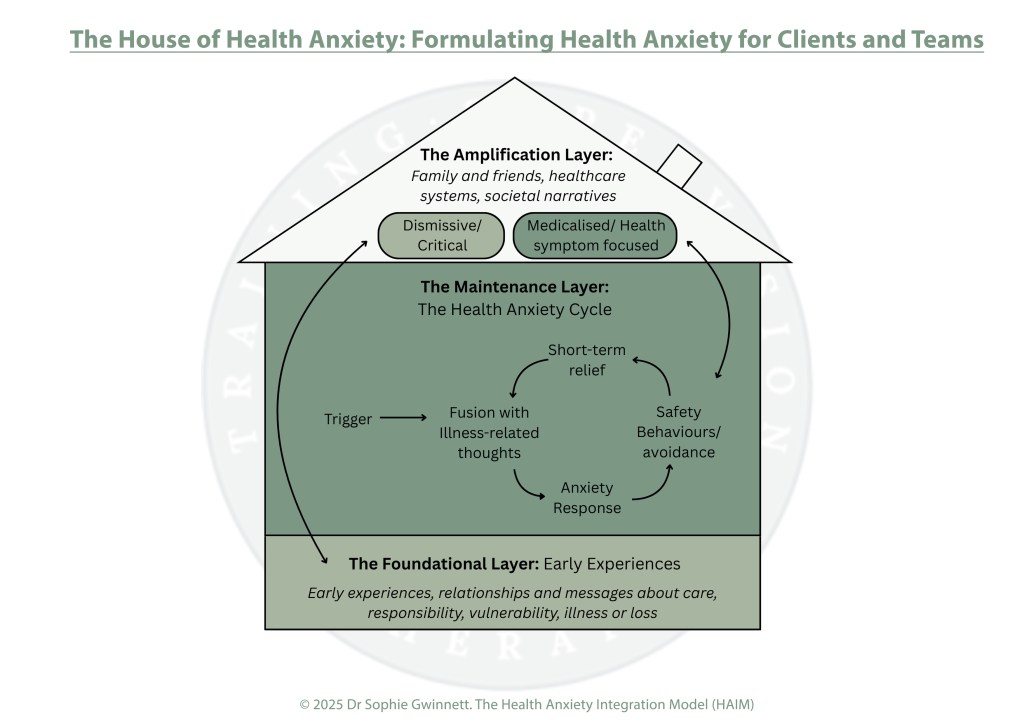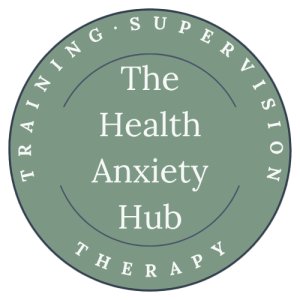The House of Health Anxiety: Formulating Health Anxiety for Clients and Teams

The Health Anxiety Integration Model (HAIM)
The Health Anxiety Integration Model (HAIM) helps us understand health anxiety not as a flaw or overreaction, but as a protective system that has developed over time, one that once was adaptive.
The model is built like a house, with three interconnected layers. Each layer represents a different level of understanding that together explain why health anxiety develops, how it keeps going, and the systems that amplify it in the present.
Understanding The HAIM
The Foundations – Early Experiences of Vulnerability, Responsibility and Care
This layer represents our early experiences that primed the nervous system for hypervigilance.
Many people with health anxiety describe earlier experiences where illness, loss or vulnerability were part of life, either their own or within the family. Some report that their experiences of being cared for were inconsistent or unpredictable. Others report growing up with caregiving responsibilities, usually for a sibling or a parent.
These early environments taught the nervous system that being responsible, vigilant or in control was the way to keep themselves or others safe.
Over time, these foundations can create deeply held beliefs such as:
- “If I’m not careful, something terrible will happen.”
- “It’s my job to prevent bad things happening to myself or others”
- “I can’t rely on others to keep me safe.”
These early emotional templates can set the stage for later bodily hypervigilance and anxiety.
Therapies designed to understand and process these early experiences can help by reducing the activation of these past experiences in the present.
The Maintenance Cycle – Thoughts, Feelings and Behaviours That Keep Anxiety Going
In the middle of the house sits the familiar “health anxiety loop.”
Internal events (for example, a muscle ache) or external triggers (for example, reading a news story about an illness) can cause catastrophic, illness related thoughts about the self. Whilst it is not uncommon for us to experience such thoughts from time to time, those with health anxiety will tightly fuse with the thoughts, believing them to be factual, important and urgent.
This thought-fusion leads to a flood of anxiety and associated physiological changes, which can then be misinterpreted as additional signs of illness. In response, people will engage in safety or avoidance behaviours designed to either seek reassurance or create distance from triggers. Such behaviours may sometimes provide some temporary relief in the short-term, but in the long-term they feed the anxiety loop by keeping people trapped in never-ending cycles of anxiety-focused thoughts and behaviours.
Therapy helps by breaking these loops and learning to respond differently to thoughts, sensations, and urges, and developing beneficial coping behaviours that no longer maintain health anxiety patterns.
The Amplification Layer – Relationships and Systems Around Us
This upper layer represents the context in which health anxiety plays out, typically within relationships, families and healthcare systems.
Others’ responses (such as reassurance, dismissal, or frustration) can amplify anxiety, reinforce early relational patterns or trigger shame.
Healthcare environments in particular can be confusing, offering reassurance one moment and uncertainty the next. Overly medicalised or symptom-focused responses from healthcare practitioners with repeated tests, scans and investigations when not clinically indicated, can prolong anxiety and uncertainty by giving the message that something is physically wrong. Dismissive responses or withdrawal of care can increase shame and uncertainty and may replicate early experiences of care, further reinforcing health anxiety patterns.
A trauma-informed approach recognises that these relational dynamics matter: they can soothe or inflame the inner protector that drives health anxiety.
By working collaboratively and compassionately, both clients and healthcare professionals can move towards connection, understanding, and shared care-planning.
In essence…
Health anxiety is not “overreacting.” or “thinking irrationally”. It’s the mind and body doing their best to protect from threat, using strategies that once made sense but now need a different approach.
The HAIM helps us see the full picture, from early relational roots, through maintaining cycles, to the relational and systemic context, so that healing can happen at each layer.

